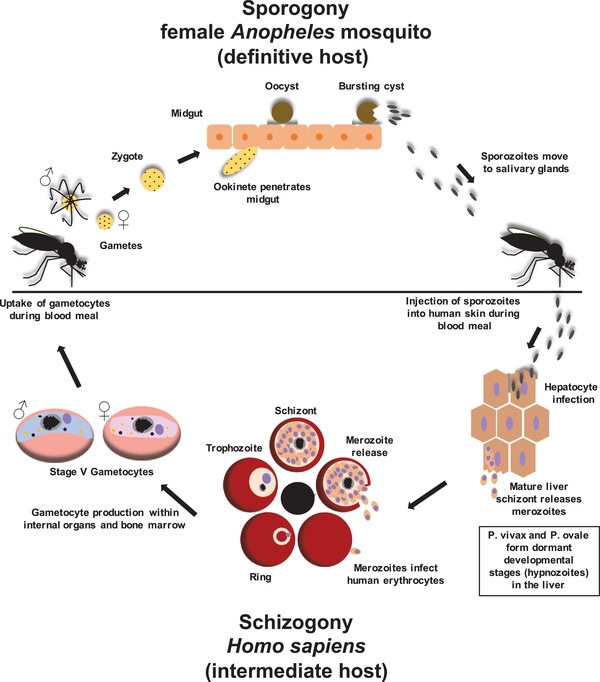Figure 1.

Life cycle of Plasmodium spp. The asexual reproduction, or schizogony, takes place in the intermediate host, while the sexual replication, or sporogony, happens in the definitive host. Throughout their life cycle, Plasmodium parasites can invade different cell types such as hepatocytes to initiate the liver schizogony and RBC to commence the erythrocytic schizogony. During the liver schizogony the sporozoite matures into a liver schizont that produces thousands of merozoites. These merozoites are released into the bloodstream where they infect the RBC of the human host for the first time and initiate the erythrocytic schizogony. Within the RBC the parasite develops into the so‐called ring stage. This is the only asexual developmental stage of the parasite that can be found in the peripheral blood of the patient. From the ring, the parasite develops into the trophozoite stage and finally into a merozoite‐producing schizont. The newly produced merozoites are released from the host RBC to find a new RBC for infection. The erythrocytic schizogony is responsible for the well‐known symptoms malaria patients experience. To facilitate the uptake by a female Anopheles mosquito, sexual stages (or gametocytes) must develop. Eventually, some parasites commence their 10‐day‐long sexual maturation. The development process of Gametocytes is divided into 5 morphological stages (I–V). In order to conduct the maturation process, immature gametocyte stages (I–IV) sequester in internal organs and the bone marrow. Only the mature stage male and female V gametocytes are released back into the bloodstream to serve their purpose of being taken up for mating by a female Anopheles mosquito during the blood meal. Within the midgut of the mosquito, male and female gametocytes mature into gametes and eventually mate by fusing into an ookinete, which migrates across the epithelial cells of the mosquito midgut. The ookinete settles beneath the epithelial cells of the midgut and develops into a sporozoite‐producing oocyst. Mature sporozoites then burst out of the oocyst and invade the salivary glands of the mosquito where they wait until for the next blood meal. During this blood meal, the sporozoites are then inoculated into the intermediate host where they first invade the hepatocytes of the liver in order to start their asexual replication. Reproduced under the terms of the Creative Commons CC‐BY license.[ 12 ] Copyright 2019, The Authors. Published by Wiley‐VCH
